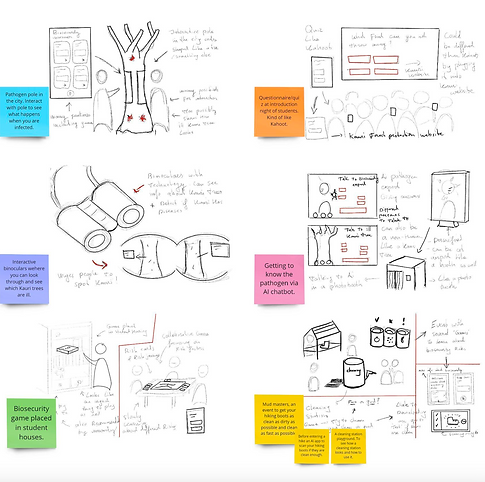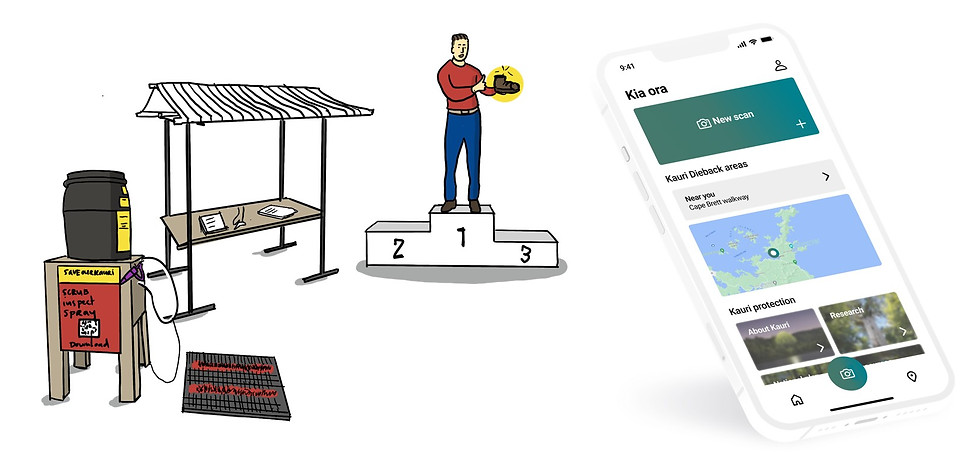Promoting responsible activity in nature through situated experiences
at Victoria University of Wellington
2023 | Kauri Dieback Scan
This UX Design Practice project, undertaken at Victoria University of Wellington, focused on tackling a critical biosecurity issue in New Zealand: the spread of Kauri Dieback. The goal was to design a digital solution to increase understanding and awareness of biosecurity risks, specifically targeting exchange students, travelers, and hikers, thereby helping to protect the vulnerable indigenous Kauri forests.


The Challenge: Information Gaps and Timeliness
New Zealand's unique island ecosystem faces distinct biosecurity threats. While border controls exist, incoming visitors, particularly students, often receive limited specific information about risks like Kauri Dieback before encountering sensitive areas. Key challenges identified were:
-
Information Overload vs. Specificity: Visitors receive a large volume of general information upon arrival, making it difficult for critical biosecurity messages to stand out.
-
Delayed Communication: Protective measures for Kauri Dieback (like boot cleaning stations) are primarily communicated at the site, potentially after contamination has occurred.
-
Human Factor: Kauri Dieback is a soil-borne pathogen spread primarily by humans moving contaminated soil on footwear or equipment.
-
Need for Proactive Awareness: There was a clear need to increase understanding and encourage preventative behaviour before individuals entered Kauri protection zones.
The Approach:
User-Centered UX Design for Environmental Protection
A User-Centered Design process was employed to develop a practical and engaging solution. The approach emphasized multiple elements.
Need for Proactive Awareness
There was a clear need to increase understanding and encourage preventative behaviour before individuals entered Kauri protection zones.
Situated
Design
Creating a tool intended for use in the specific context of preparing for and undertaking hikes.
OneHealth &
Cultural Context
Designing with a high regard for nature, reflecting New Zealand's strong cultural connection to the environment and serious approach to biosecurity.
Accessibility & Usability
Adhering to UX heuristics and accessibility guidelines throughout the design process.

The Process: From Problem Definition to Tested Concept
Problem Definition
Synthesizing research and context to clearly define the core issues surrounding Kauri Dieback awareness and the target user group. Formulated the key research question: How can we increase understanding of biosecurity risks for exchange students visiting New Zealand, with a case study focused towards the Kauri forest dieback?
Ideation
Generated a broad range of potential solutions (24 ideas) encompassing general biosecurity and Kauri-specific measures, exploring different levels of user engagement and intrusiveness.
Concept Selection
Systematically evaluated ideas using frameworks including Casual/Educational vs. Intrusive/Attention axes and an Impact/Effort matrix. This process prioritized concepts with high potential impact and reasonable feasibility, leading to the selection of a mobile application concept.
Conceptualization & Prototyping
Developed the chosen app concept, defining core features and user flows. Created interactive prototypes visualizing key screens, including onboarding, information sections, location finding, and the AI shoe scanning process.
User Testing
Conducted usability testing with target users, focusing on:
-
User behaviour and comfort with location sharing features.
-
Comprehension and usefulness of information provided.
-
User experience and intuitiveness of the AI shoe scanning interaction.
Iteration & Refinement
Analyzed user feedback to identify areas for improvement and iterated on the design. Key refinements based on insights included:
-
Enhanced Onboarding: Adding clearer explanations of app features, AI privacy, the risks of entering Kauri forests, and the purpose of scanning.
-
Streamlined UI: Focusing the home screen on core actions (scanning, finding locations) and removing less critical elements like scan history.
-
Simplified Scan Flow: Implementing a simpler 'Continue' button interaction during the multi-stage scan.
-
Clear Confirmation: Providing explicit confirmation upon scan completion, with links to integrated hiking apps (like AllTrails) to start the hike.
-
Heuristic & Accessibility Compliance: Ensuring clear status visibility, error prevention, user control (e.g., ability to quit scan), and considering color accessibility.

The Outcome: A Biosecurity Awareness App Concept
The project resulted in a well-defined concept for a mobile application, "Kia ora Kauri", designed as a situated tool for hikers and travelers. With the purpose of proactively raising awareness about Kauri Dieback and facilitate biosecurity compliance.
Key Features:
-
Information Hub: Providing accessible information about Kauri Dieback, its spread, and protection measures.
-
AI Shoe Scanner: A tool utilizing AI technology (conceptualized) to allow users to scan their footwear before entering a Kauri area, providing feedback on cleanliness.
-
Location Awareness: Integration with location services to notify users when they are near designated Kauri Dieback risk zones.
-
Hiking App Integration: Planned links to popular hiking apps to seamlessly integrate biosecurity checks into the hiking preparation workflow.
-
User-Friendly Interface: Designed based on iterative user testing, incorporating usability heuristics and accessibility considerations.

